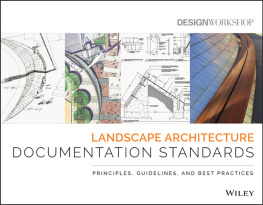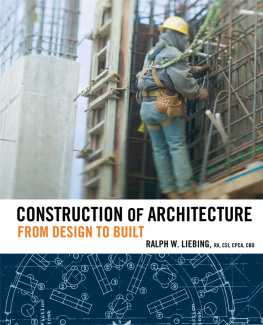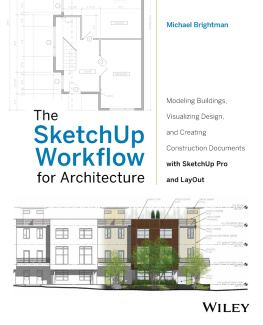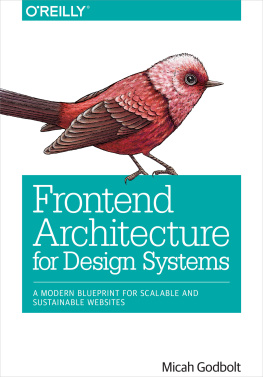
Landscape Architecture
Documentation Standards:
Principles, Guidelines,
and Best Practices
DESIGNWORKSHOP
Cover image: DesignWorkshop
Cover design: Wiley
This book is printed on acid-free paper.
Copyright 2016 by Design Workshop, Inc. All rights reserved
Published by John Wiley & Sons, Inc., Hoboken, New Jersey
Published simultaneously in Canada
No part of this publication may be reproduced, stored in a retrieval system, or transmitted in any form or by any means, electronic, mechanical, photocopying, recording, scanning, or otherwise, except as permitted under Section 107 or 108 of the 1976 United States Copyright Act, without either the prior written permission of the Publisher, or authorization through payment of the appropriate per-copy fee to the Copyright Clearance Center, 222 Rosewood Drive, Danvers, MA 01923, (978) 750-8400, fax (978) 646-8600, or on the web at www.copyright.com. Requests to the Publisher for permission should be addressed to the Permissions Department, John Wiley & Sons, Inc., 111 River Street, Hoboken, NJ 07030, (201) 748-6011, fax (201) 748-6008, or online at www.wiley.com/go/permissions.
Limit of Liability/Disclaimer of Warranty: While the publisher and author have used their best efforts in preparing this book, they make no representations or warranties with the respect to the accuracy or completeness of the contents of this book and specifically disclaim any implied warranties of merchantability or fitness for a particular purpose. No warranty may be created or extended by sales representatives or written sales materials. The advice and strategies contained herein may not be suitable for your situation. You should consult with a professional where appropriate. Neither the publisher nor the author shall be liable for damages arising herefrom.
For general information about our other products and services, please contact our Customer Care Department within the United States at (800) 762-2974, outside the United States at (317) 572-3993 or fax (317) 572-4002.
Wiley publishes in a variety of print and electronic formats and by print-on-demand. Some material included with standard print versions of this book may not be included in e-books or in print-on-demand. If this book refers to media such as a CD or DVD that is not included in the version you purchased, you may download this material at http://booksupport.wiley.com. For more information about Wiley products, visit www.wiley.com.
Library of Congress Cataloging-in-Publication Data: 978-0-470-40217-7 (pbk); 978-1-118-41512-2 (ebk); 978-1-118-41807-9 (ebk)
ACKNOWLEDGMENTS
This publication was prepared by Design Workshop, a planning, urban design and landscape architecture firm. The publication represents the efforts of dozens of professionals, including landscape architects, architects, graphic designers, technical writers and quality control specialists. Key content was provided by senior and most experienced landscape architects, including several prestigious Fellows of the American Society of Landscape Architects.
Principles, best practices and documentation requirements were gathered in extensive work sessions dedicated to very specific and detailed topics such as line-weight hierarchies and plan layout strategies. Exhaustive detail was elicited from project teams and the project documents they prepared. Initial versions of this document were prepared as part of an internal training course to educate professional landscape architects in a private-practice setting. These training courses, across a number of offices, were also used as forums to debate and develop additional content.
Over the course of several years, the guidelines were further developed and re-issued as improved and expanded versions. Quality Management Directors within the landscape architecture firm were asked to administer the application of the guidelines and solicit additional input and content. Peer reviews were conducted on early versions, whereby comments were collected from reputable landscape architects across the United States and university faculty responsible for teaching documentation practices.
The publication includes graphic documentation from several Design Workshop offices for projects and are used to guide teams in successfully completing project design and documentation in a variety of cities. These guidelines were applied to these projects.
Document authorship, assembly, organization and production were completed by the following individuals:
Primary Author: Chuck Ware.
Supporting Content and Editing: Kurt Culbertson, Paul Squadrito.
Additional Contributors, including content development, review, coordination, layout and graphics:
Bruce Hazzard, Kate Kennan, Ethan Moore, Kathy Bogaski, Yun Soo Kim, John Haynes, Gyles Thornley, Isadora Gailey, Nino Pero, Natalie Grillo, Jake Sippy, Jason Ferster, Allyson Mendenhall, Jamie Fogle, Ben Fish, Troy Cook, Alex Ramirez, Steven Spears, Jesse Young, Emily Bauer, Thomas Wortman, Charlie Hunt, Evan Peterson, Elizabeth Boudreaux and Lara-Anne Stokes Bradley, Jing Lei and Jacky Wah.
Professional Peer Review Contributors: James Urban, Patrick Quigley, Peter Trowbridge, David Evans, Richard L. Hindle, Howard Hahn, Chip Winslow, Sean Michael, Bruce Sharkey and Jerry Cavaleri.
Patrick Quigley, from Patrick B. Quigley and Associates, lighting designers, made significant content contributions to the lighting design and documentation sections.
KWG Property Holding Limited, Guangzhou, Guangdong, China for the Suzhou Block 5-8 Project, of which there is project documentation included within this publication.

College of Sante Fe, Sante Fe, New Mexico
SECTION 1 Establishing the Foundation
Introduction
Documentation Principles
Operational Principles
INTRODUCTION
BACKGROUND
In its relatively short American history, the role of landscape architecture has been broad, diverse, and impactful. Landscape architects have been influential in making the post-industrial city more humane and livable. They have broadened the duties of transportation networks and transformed the function of open space systems. They have defined and redefined what makes great communities. They have been integral to environmental progress and are conceiving new approaches for infrastructure to provide environmental and community benefits. Also, landscape architects have brought art and culture to many through their work. Moreover, their work has significantly benefited economic development in many cities and regions.
While the impact of landscape architecture has been impressive, the ongoing potential for this noble profession continues to materialize. Its potential can be even more transformative if it responds to the most critical global problems: economic, environmental, and social. Many of these problems languish at crisis level, and consequently, the opportunity for landscape architectural leadership is both critical and challenging. Innovation and change will be key components of this prodigious undertaking.
Solutions to problems will necessarily be derived from rigorous interdisciplinary analyses, research, and exploration. Solutions will be most sustainable if they are comprehensive in nature, deriving long-term synergies between prosperity, environmental healing, and improved quality of life. While much of the work of landscape architects is delivered figuratively in the form of plans, reports, and guidelines, the most decisive impact comes in the form of built work. The built work must be well executed, that is, perform well, in order to fulfill ambitious intent. Processes for translating objectives and ideas into built outcomes need to be advanced and carefully applied just as they are in other industries where vital products are delivered to market.
Next page











